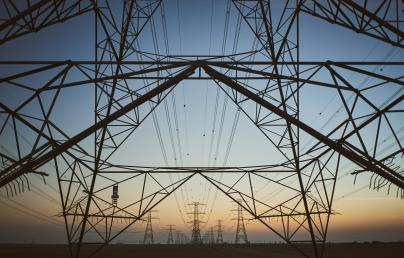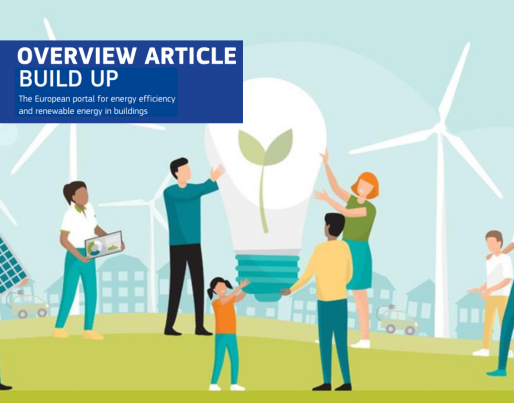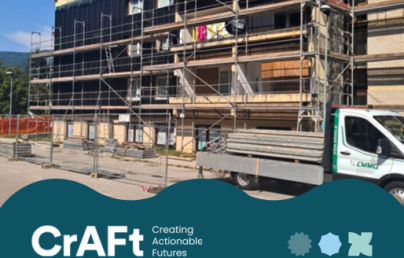
Energy communities and citizen-led initiatives for sustainability in buildings

Energy communities and citizen-led initiatives for sustainability in buildings
What if citizens could not only be active participants in the energy transition but also reap economic and social benefits?
Collective, non-discriminatory, citizen-driven initiatives that support the clean energy transition and energy communities start mainly as renewable energy projects. These initiatives are increasingly involved in the progressive renovation and decarbonisation of the building sector. They aim at collective social and environmental well-being rather than profit, often with the additional objective of combating energy poverty by making the cost of energy more affordable.
Photo @Joint Research Centre (JRC), https://creativecommons.org/licenses/by-sa/4.0/
Introduction
Energy communities, at their core are collective endeavours where individuals, households, or organisations collaborate in the field of energy. They often start with an energy generation project (leveraging renewable sources like solar, wind, or hydroelectric power) but they are increasingly active in other areas such as energy renovation of buildings, heating, or green mobility.
Members can include citizens, local authorities (such as municipalities), and small and medium-sized enterprises.
Energy communities allow local communities to join forces and invest in clean energy. Acting as a single entity; they can access all suitable energy markets on a level-playing field with other market actors. Under EU law energy communities can take the form of any legal entity including an association, a cooperative, a partnership, a non-profit organisation or a limited liability company.
Additionally, forming energy communities can offer several benefits, such as those shown in Figure 1.0.
Figure 1.0. Potential benefits of energy communities. Source: https://energy-communities-repository.ec.europa.eu/energy-communities-repository-energy-communities/energy-communities-repository-general-information_en
In addition, energy communities can also:
enhance energy efficiency
reduce local carbon footprint
foster energy independence
reduce energy poverty
create local green jobs
A key role of energy communities is to help generate awareness and engagement among citizens in the energy transition.
Two types of energy communities are distinguished in European legislation:
Citizen Energy communities (CECs), defined in the Directive on common rules for the internal electricity market
Renewable energy communities (RECs), presented in the 2018 recast of the Renewable Energy Directive
Figure 2: Comparison between the definitions of RECs and CECs. Source: REScoop.eu https://www.rescoop.eu/uploads/rescoop/downloads/QA-What-are-citizens-energy-communities-renewable-energy-communities-in-the-CEP.pdf
This article will focus mainly on RECs as they are mentioned in the most up-to-date European Directives. For a more in-depth discussion of CECs and a comparison with RECs see this Overview Article.
The building sector is pivotal in the development of energy communities. An energy community can be established by a single multi-apartment building, enhanced, for instance, with photovoltaic panels installed on its rooftop. Furthermore, a group of buildings or an entire district can collectively form an energy community, leveraging shared renewable energy resources. Therefore, not only does the building become an integral component of the community, but it is often generating renewable energy by exploiting its structure.
Figure 3.0 The boundaries of an energy community are highly flexible, extending from a single multi-apartment building to an entire district that shares energy from a common renewable source. Photo by Pixabay: https://www.pexels.com/it-it/foto/fotografia-ad-alto-angolo-del-villaggio-280221/
EU policy framework in Energy Communities
Revised Renewable Energy Directive
The Revised Renewable Energy Directive introduces several significant updates that aim to bolster the adoption and integration of renewables across Europe. While the core provisions regarding Renewable Energy Communities remain unchanged and have been detailed previously in this Overview Article, the revised text expands into several new areas. We report the main updates:
Offshore Renewables: The Directive encourages Member States to actively promote local involvement in offshore renewable energy projects, particularly through direct ownership schemes.
Building Sector's Consumption: A key addition is the establishment of a new indicative target: by 2030, at least 49% of energy consumed in the building sector should be renewable. Member States are required to define national shares for on-site or nearby renewable energy production under Article 15a. The directive suggests enhancing self-consumption and fostering renewable energy communities.
Renewables Acceleration Areas: Member States are mandated to coordinate comprehensive mapping for the deployment of renewable energy at national, regional, and local levels by May 2025. By February 2026, they must designate 'renewables acceleration areas' for various renewable sources. Emphasising the importance of public acceptance, the directive urges engagement with local communities in these projects.
Simplified Procedures: The directive enhances permitting rules to streamline processes and improve transparency.
District Heating and Cooling: Recognising the critical role of renewable energy in heating and cooling sectors, the Directive encourages Member States to implement specific measures aimed at promoting district heating and cooling networks powered by renewables and waste heat, mentioning RECs as vehicles to achieve this purpose.
For further analysis of these points and a series of recommendations to Member States, we recommend this briefing by REScoop, the European federation of citizen energy cooperatives.
Energy Performance of Building Directive
The revised Energy Performance of Buildings Directive (EPBD) sets ambitious targets for achieving Zero Emission Buildings (ZEBs) throughout the EU (articles 2.2 and 9b). It defines ZEBs as highly energy-efficient structures with no onsite fossil fuel emissions and minimal operational greenhouse gases. By 2030, all new buildings must meet ZEB criteria, with public buildings mandated to achieve this status by 2028. The directive emphasises the role of energy communities in achieving these goals, promoting their involvement in renewable energy integration, efficient district heating, and carbon-free sources.
Additionally, the directive mandates the establishment of operation and technical assistance facilities, or One-Stop-Shops (OSS), across regions to provide comprehensive technical and financial assistance for building renovations, prioritising accessibility and support for energy-poor households and district-level projects. OSS should align with Article 22 of the Energy Efficiency Directive, ensuring that information on energy efficiency measures is transparent and accessible. This includes support for energy communities, that in several EU Member States, such as Ireland, France, and Belgium, have established dedicated OSS to support citizen-led renovations, in addition to benefiting from existing OSS at local and national levels.
In relation to energy communities, REScoop carried out a detailed analysis with recommendations for Member States.
Amending electricity market design Directive
The directive acknowledges the rise in energy and gas prices, partly due to the Russian-Ukrainian conflict. Consequently, it is deemed necessary to strengthen the internal energy market, particularly the renewable sector, to ensure affordable and secure energy for European citizens. To this end, among the recommendations for Member States within the directive is to encourage and facilitate the formation of CECs and RECs.
Financial instruments and initiatives
At the EU level, the European Parliament provided funding for several projects to foster energy communities in Europe:
The Energy Communities Repository (ECR) and the Rural Energy Community Advisory Hub (RECAH) provided technical assistance to local actors and citizens willing to set up energy communities. Beyond technical assistance, these initiatives compiled existing tools, guidance and inspiring case studies.
The Support Service for Citizen-Led Renovation (CLR) aims to empower energy communities to manage energy-saving renovations in buildings. So far it has supported pilot projects in Belgium, Portugal, Ireland, and Bulgaria, overcoming financial, legal, and technical barriers. The 2024 call for pilots will extend the support to new communities and organise webinars, and peer learning. A public tender for Phase III of the CLR support service was published in June, with deadline for receipt of tenders on 10 September.
Some elements of the ECR and RECAH will be given continuity under the Energy Communities Facility funded by the LIFE Clean Energy Transition (CET) Programme. The objective of the Facility will be to help professionalise energy communities and mature nascent energy community projects until they develop feasible technical plans and investment concepts. For that, it will provide direct financial support to the initial stages of community energy projects in the areas of energy efficiency, innovative energy services or any form of renewable energy.
Furthermore, the Commission is evaluating a tender for a Citizen Energy Advisory Hub, aiming to assist citizens and their trusted intermediaries to set up or facilitate citizen energy projects through technical, regulatory, communication and outreach, organisational, financial and administrative advice and encourage their development. It will not focus solely on energy communities but some of its outputs will be relevant for the sector.
As well as those initiatives, programmes such as LIFE Clean Energy Transition or Horizon Europe (or, in the past Horizon 2020) also have calls for projects related to energy communities.
At Member State level, governments are responsible for the actual implementation of legislation regulating energy communities. Some Member States have been very active in their promotion and the sector is growing fast as a result. To mention a few examples, Italy promotes the formation of energy communities through various incentives and funding mechanisms, including EUR 2.2 billion from the National Recovery and Resilience Plan. The Spanish government, through the Incentive Programme for Unique Pilot Projects of Energy Communities, has granted more than EUR 70 million to 129 energy community projects (March 2024). Ireland, through the Sustainable Energy Authority of Ireland, provides grants and support to communities. EU countries may also target vulnerable households, micro-enterprises, and transport users through energy communities under the Social Climate Fund Regulation (EU) 2023/955.
An overview of the different legal transpositions of the various Member States can be found on this page.
European projects (non-exhaustive list)
The LIFE Clean Energy Transition Programme supports energy community projects through its annual calls. In the past, Horizon 2020 and now Horizon Europe also support some energy community projects.
Horizon Europe
Rapid energy sector developments fulfilling green deal goals enhance access for energy-activated citizens and secure communities. The EU-funded ENPOWER project supports a citizen-centric system by combining advanced ICTs, social-behavioural insights, and innovative business models to offer essential tools like social science frameworks, critical AI algorithms, and energy community planning tools.
Life Projects
ENCOM HUB will aid the creation of citizen, SME, and public authority-owned Energy Communities in France, Spain, Italy, and Bulgaria. It focuses on designing, validating, and scaling services for these communities, including information, training, participatory management, techno-economic analysis, and legal, administrative, and financial support.
POWER-E-COM seeks to enhance cooperation between local authorities and citizens for community energy projects in six European countries (Austria, Bulgaria, Germany, Ireland, Slovenia, and Spain) at various stages of adopting EU directives. The initiative will train and support stakeholders, fostering energy communities and innovative business models. Expected outcomes include €21.4M investment, 9.2 GWh/y energy savings, 37.3 GWh/y renewable energy, and a 30,700 t CO2/y emissions reduction.
Youth leadership in energy communities is vital for the energy transition. POWERYOUTH aims to empower young people through a participatory approach, developing tools for engagement, decision-making, and finance. Implemented in 5 EU countries, it targets creating 10 youth energy communities, involving 1,000+ individuals, and training future leaders.
JALON fosters citizen-led energy communities in Europe, focusing on rural areas lacking tailored legislation. By engaging 5,000 citizens, 40 local authorities, and 75 businesses, it aims to address social needs and drive local development. The project aims to invest €13M in photovoltaic energy, avoiding 3,452 tons of CO2 annually and influencing other EU regions.
Energy communities boost local renewable energy and efficiency. Local governments can foster these initiatives but face concerns about commercialisation and un-transposed directives. The TANDEMS project, involving regions from Belgium, the Netherlands, and Bulgaria, aims to create replicable models for citizen engagement in clean energy, with targets including 67 projects and 10.15 GWh/year in renewable generation by 2025.
LIFE21-CET-ENERCOM-LIFE-BECKON
LIFE-BECKON boosts Energy Communities across Europe by offering support mechanisms, including a Technical Assistance cookbook, a capacity building programme, and a One-Stop-Shop platform. Tested in Avila, Sofia, and Copenhagen, the project aims to impact over 2,500 citizens and save 20 GWh/year in energy by involving 90+ entities.
LIFE-COMET aims to build community energy coalitions in Eastern Europe, supporting Greece, Croatia, Romania, Hungary, Slovenia, Poland, and Estonia. It fosters collaboration among stakeholders to improve frameworks, provides training and assistance to new projects, and promotes peer exchanges. The project will scale up to include additional Eastern European countries.
Several EU projects have boosted energy communities, but they often struggle to take off. The COMANAGE proposal aims to overcome governance barriers through an Energy Communities Governance Framework and Toolkit. It will support existing and new community energy projects by mobilising stakeholders and establishing service hubs in Barcelona, Krakow, and Lazio.
ACCE, or Access to Capital for Community Energy, is a project to scale up financing tools for European energy cooperatives. It aims to create five Community Energy Financing Schemes (CEFS) in five countries, expand existing CEFS in the Netherlands and France, establish a European intermediary, and trigger €90 million in citizen investments.
Energy Cities, Electra, ZEZ, Cooperativa de Energie, and REScoop.eu have launched a programme, LIFE LOOP, to help local authorities achieve sustainable energy goals through community energy projects in Crete, Zagreb, and Bistrita. The project will be replicated in Bulgaria, Cyprus, Romania, and Italy, and promoted in the Western Balkans. Key focus areas include capacity building, funding, regulatory simplification, and energy justice.
The ‘One Stop Renovation Co-op’ project will develop and pilot three integrated building renovation services focused on deep renovation for households. It will create a replication toolkit and training for 3000+ European energy cooperatives. The project aims to identify best practices and create financially viable, community-led renovation services.
Conclusion
Energy communities represent a transformative approach to the energy transition, driven by collective citizen action and supported by robust EU policies and funding mechanisms. As energy communities grow, they democratise energy production and consumption, engaging citizens in the energy transition and positioning local communities at the heart of sustainable development. This model, supported by EU legislation and financial instruments, underscores the potential for a more inclusive and equitable energy future.

